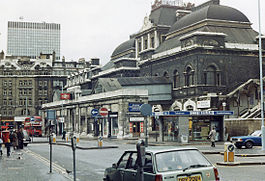Broad Street railway station (London)
| Broad Street | |
|---|---|

Broad Street in 1983
|
|
|
Location of Broad Street in Central London
|
|
| Location | City of London |
| Local authority | City of London |
| Grid reference | TQ331817 |
| Number of platforms | 9 |
| Railway companies | |
| Original company | North London Railway |
| Pre-grouping | North London Railway |
| Post-grouping | London, Midland and Scottish Railway |
| Key dates | |
| 1 November 1865 | Station opened |
| 30 June 1986 | Station closed |
| Replaced by | Liverpool Street |
| Other information | |
| Lists of stations | |
| WGS84 | 51°31′08″N 0°05′00″W / 51.5189°N 0.0833°WCoordinates: 51°31′08″N 0°05′00″W / 51.5189°N 0.0833°W |
|
|
|
Broad Street was a major terminal station in the City of London, adjacent to Liverpool Street station. It was opened in 1865 as the main terminus of the North London Railway network of suburban services.
It closed in 1986 following years of diminishing passenger usage.
The extension of the North London Railway (NLR) to Broad Street (via the Kingsland Viaduct) was authorised by the North London Railway Act of 22 July 1861. The station was opened on 1 November 1865 as the terminus of a network of commuter railways linking east and west London via the looping route of the NLR, originally with seven platforms and three approach lines. A goods station was situated next to the passenger station opening to traffic on 18 May 1868. It was built on a deck and a lift was provided to move wagons down to warehouses below. The deck was not strong enough to carry locomotives, so shunting was done by rope and capstan.
A fourth approach line was added in 1874, a further (eighth) platform in 1891, and a final (ninth) platform in 1913. At its peak, Broad Street was the third-busiest station in London (after Liverpool Street and Victoria). At the start of the 20th century, more than one train per minute arrived or departed Broad Street during rush hour, with over 27 million passengers in 1902. The Great Northern Railway also used Broad Street as a supplement to its King's Cross terminal some miles to the west.
In the early years of the 20th century the North London Line suffered a drastic loss in passengers and, especially, revenue, owing to the expansion of the bus, tram and Underground networks. For example, from 1900 to 1905, passengers dropped by 4 per cent and 13.4 per cent; by 1913 numbers had dropped to 44.6 per cent compared to 1900, and by 1921 to only 23.3 percent. The patronage of Broad Street station declined accordingly. This was not helped by the fact that on 8 September 1915 the station was damaged by an enemy Zeppelin attack.
...
Wikipedia

